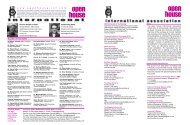Vol :37 Issue No.1 2012 - Open House International
Vol :37 Issue No.1 2012 - Open House International
Vol :37 Issue No.1 2012 - Open House International
You also want an ePaper? Increase the reach of your titles
YUMPU automatically turns print PDFs into web optimized ePapers that Google loves.
Donovan Gottsmann and Amira Osman<br />
open house international <strong>Vol</strong>.<strong>37</strong> <strong>No.1</strong>, March <strong>2012</strong> Environments of change: an <strong>Open</strong> Building approach...<br />
robust and nuanced, on how these chasms<br />
[between the rich and the poor] can be bridged... It<br />
would be disrespectful of the dignity of those who<br />
had been shut out in the past to say that they should<br />
now be satisfied with having access to shoddy and<br />
styleless buildings based on the principle of bare<br />
necessities only. Elegance, accomplishment and<br />
suitability for purpose are factors appreciated by all,<br />
whether in dress, dance, music, speech-making, or<br />
sport or building... [there is therefore] no inherent<br />
incompatibility between a building being friendly to<br />
the public, on the one hand, and pleasingly, coherently<br />
and efficiently designed on the other.” (SAIA<br />
awards report, 2010)<br />
Based on the above principles, the proposed<br />
design for a specific case study area in<br />
Mamelodi, South Africa strives to act as both a symbol<br />
of hope and progressive change.<br />
T H E I N F O R M A L S EC T O R I N<br />
MAMELODI, TSHWA NE<br />
Mamelodi is a residential suburb approximately<br />
25km² in area and was originally established in the<br />
1940s as a township for black workers near the<br />
train station at Eerste Fabrieken. In time Mamelodi<br />
expanded to the East beyond the Pienaars Rivier,<br />
locally known as the Moretela River. Mamelodi is<br />
divided into two sectors by the Pienaars Rivier,<br />
Mamelodi West and Mamelodi East. Mamelodi<br />
West shares a distinct border with the established<br />
township of Eersterust to the West and the industrialised<br />
area of Silverton to the South-West. The<br />
Magaliesberg mountain range defines the northern<br />
perimeter of the greater Mamelodi. Mamelodi East<br />
is bound by the North-South lying branch of the<br />
Magaliesberg mountains and commercial and residential<br />
development to the South in the Willows.<br />
Mamelodi East contains a great deal of informal<br />
dwellings, particularly in the extreme East where<br />
there is significantly less formal housing and limited<br />
infrastructure.<br />
Mamelodi still shows traces of its numerous<br />
growth patterns, both from its pre-apartheid and<br />
post-apartheid eras. It displays evidence of the<br />
diverse urban planning typologies practised during<br />
the changing years of government and the fusion of<br />
incongruent road grids as well as contrasting forms<br />
7 4<br />
of housing typologies. Unconstrained growth of<br />
informal shacks is depicted by the smaller informal<br />
grid patterns.<br />
In Tshwane, South Africa, as in other<br />
places, there exists a certain order within the apparent<br />
chaos of informal settlements. Internal policing,<br />
construction and trading are all resolved and carried<br />
out on a scale suited to context, available<br />
resources and paying power. Informal settlements<br />
establish cultural, social and individual roots which<br />
in turn support the greater structure of the settlement<br />
and the community.<br />
The area of Mamelodi is rapidly expanding<br />
and swallowing up auxiliary informal settlements on<br />
the peripheries, and at the same rate giving rise to<br />
new informal “offspring” as informal residents<br />
located on the erratic edges would either move into<br />
the new formal housing or, together with newer<br />
immigrants, would again relocate to the shifting<br />
outskirts of the township. These informal settlements<br />
have been continuously uprooted and displaced by<br />
the expanding formal urban fabric of the township.<br />
The informal settlements in the extreme East and<br />
South-East of Mamelodi (informally known as<br />
Lusaka and Phumolong) were identified as areas in<br />
urgent need of basic services with high fire risks and<br />
poor sanitary conditions.<br />
The informal sector of Mamelodi east consists<br />
predominantly of wards 10, 16 and 17.<br />
Collectively these wards comprise more than one<br />
third of the area of Mamelodi served by 1 clinic in<br />
ward 17. Sanitation is inadequate with poor health<br />
circumstances as result. Much of the material used<br />
to construct the shacks is obtained from the surrounding<br />
industries, mostly from the Ford manufacturing<br />
plant in Silverton. Many informal dwellings<br />
encroach upon the Magaliesberg on the eastern<br />
front. The threat of shack fires exists due to the high<br />
combustion rate of the building material and the<br />
high densities.<br />
Much of the current formalised township of<br />
Mamelodi East is composed of consolidated informal<br />
settlements, in which land previously subdivided<br />
without approval is sold or leased to the informal<br />
residents and has overtime been recognised as<br />
part of the township. Improved infrastructural networks<br />
are thus provided and these informal settlements<br />
are merged within the recognised township.<br />
However, and in contrast, in some cases squatters





